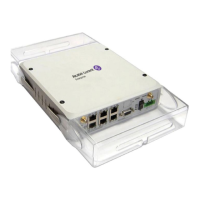Installing the Components
7705 SAR-8 Installation Guide Page 101
Tools required:
• torque driver for Phillips screws
To install a Fan module:
Step 1. Remove the Fan module from the packaging and place it on an anti-static work
surface. Avoid touching the board components and connector pins.
Step 2. Insert the Fan module into the Fan slot. Align the Fan module with the slot guides and
the captive screw with the threaded receptacle.
Step 3. Press the Fan module firmly into the slot. Make sure that the connectors are fully
seated in the backplane connectors.
Step 4. Secure the Fan module to the chassis, using a calibrated torque screwdriver set at
4-6 lbf-in. Do not over-tighten.
Adapter Cards
The 7705 SAR-8 supports the following adapter cards:
• 16-port T1/E1 ASAP Adapter card
• 8-port Ethernet Adapter card (version 1 and version 2)
• 4-port OC3/STM1 Clear Channel Adapter card
• 2-port OC3/STM1 Channelized Adapter card
• 12-port Serial Data Interface card
Adapter cards are installed in slots MDA 1 through MDA 6. The 7705 SAR-8 supports up to
six adapter cards, in any combination that does not exceed the maximum. See Figure 5 on
page 45 for slot identification. Figure 27 illustrates the installation of an adapter card.
The 16-port T1/E1 ASAP Adapter card supports 16 individual T1/E1 ports through a single
cable connection to a distribution panel. The 8-port Ethernet Adapter card supports six
10/100 Base-T ports and two SFP ports for 10/100/Gigabit Ethernet SFPs (optical or
electrical) and T3 SFPs. Four SFP ports are supported on the 4-port OC3/STM1 Clear
Channel Adapter card and two SFP ports are supported on the 2-port OC3/STM1
Channelized Adapter card, for fiber or copper connectivity using SFP modules. For more
information on installing an SFP, see SFPs on page 103.
The 12-port Serial Data Interface card has four 68-pin connectors on its faceplate. Each
connector supports three data ports. The Serial Data Interface card data ports operate in
access mode only and can be configured for a V.35 or RS-232 (also known as EIA/TIA-232)
interface.
